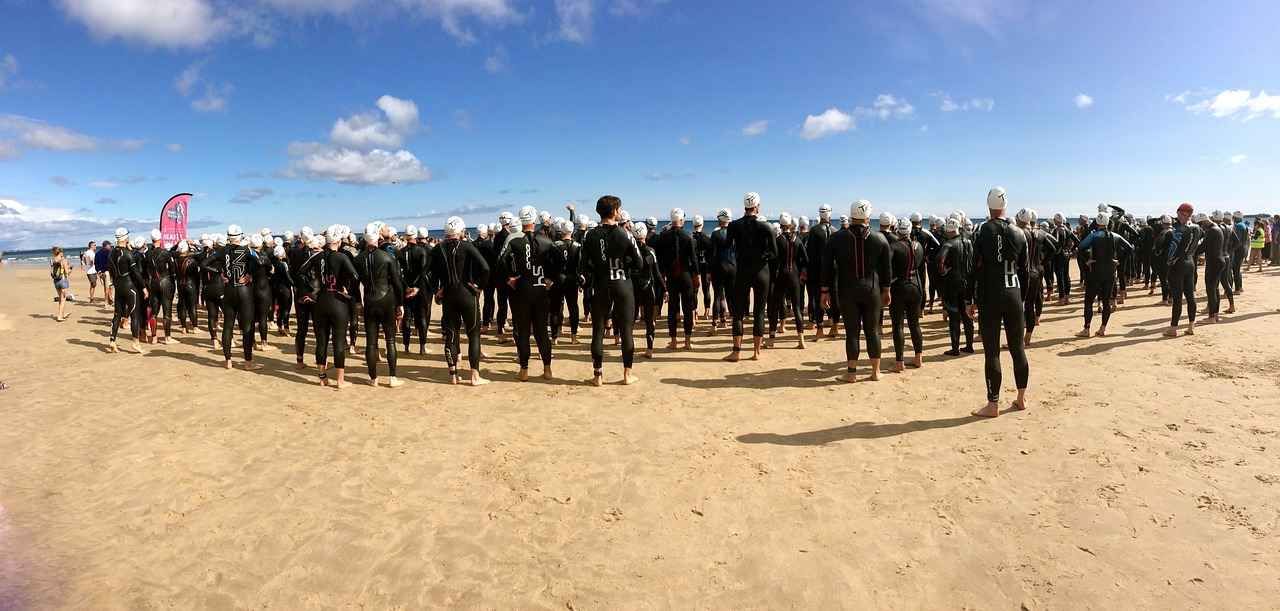Running 100 miles is no small feat, and understanding the various factors that influence the time it takes to complete this distance is essential for both novice and experienced ultra-runners. This guide delves into the numerous elements that can affect race times, offering valuable insights to help runners prepare effectively.
The time it takes to finish a 100-mile race is influenced by several critical factors, including:
- Terrain – The type of ground can significantly impact pace.
- Weather Conditions – Temperature, humidity, and wind can alter performance.
- Runner’s Fitness Level – Experience and training play a crucial role.
The nature of the terrain is one of the most significant factors affecting completion times. Runners must consider:
- Flat vs. Hilly Courses – Races on flat terrain generally allow for faster completion times, while hilly routes can slow runners considerably.
- Impact of Elevation Gain – Courses with substantial elevation gain require more energy, affecting pacing and overall time, especially for less experienced runners.
- Trail Conditions – The state of the trail, including mud, rocks, and other obstacles, can hinder speed and efficiency.
Understanding average completion times can help set realistic expectations. Generally, elite ultra-runners complete 100 miles in:
- 12 to 16 hours for top performers.
- 24 to 30 hours for average runners.
Individual training, experience, and race day conditions can lead to significant differences in completion times among runners.
Proper training is essential for successfully completing a 100-mile race. Key aspects include:
- Building Endurance through Long Runs – Incorporating long runs into training regimens helps build the endurance necessary for tackling ultra-distances effectively.
- Strength Training and Injury Prevention – Strength training can enhance performance and reduce the risk of injuries, making it a vital component of 100-mile race preparation.
Mental preparation is crucial for ultra-runners. Strategies include:
- Visualization Techniques – Utilizing visualization can help runners mentally prepare for race scenarios, boosting confidence and focus.
- Dealing with Mental Fatigue – Strategies such as positive self-talk and goal setting can enhance a runner’s ability to push through challenging moments.
Effective race strategies can improve performance and overall enjoyment. Key considerations include:
- Nutrition and Hydration Tips – Understanding proper nutrition and hydration strategies is essential for maintaining energy levels throughout the race.
- Pacing Strategies for Success – Effective pacing can help runners avoid burnout and ensure they maintain a sustainable speed throughout the race.
By considering these factors and employing effective training and mental strategies, runners can enhance their chances of successfully completing a 100-mile race. Whether you are a beginner or a seasoned ultra-runner, understanding the intricacies of ultra-distance running is vital for achieving your personal best.

What Factors Affect the Time to Complete 100 Miles?
Running a 100-mile race is a formidable challenge that requires not just physical endurance but also a deep understanding of various factors that can affect completion times. In this section, we will explore the key elements that contribute to how long it takes to finish a 100-mile race, providing insights that are valuable for both novice and experienced runners.
Several critical factors influence the duration of a 100-mile race. Among these, terrain, weather conditions, and individual fitness levels stand out as the most significant.
- Terrain: The nature of the course plays a pivotal role. Runners face different challenges depending on whether they are on a flat, hilly, or mountainous course. Flat terrains generally allow for faster times, while hilly courses can significantly slow runners down due to the increased physical effort required.
- Weather Conditions: Weather can dramatically impact performance. For instance, high temperatures can lead to dehydration and fatigue, while rain can make trails slippery and challenging. It’s essential for runners to prepare for the specific weather conditions expected on race day.
- Individual Fitness Levels: Each runner’s training regimen, experience, and physical condition will ultimately dictate their performance. Runners who have built a solid base of endurance and strength will generally fare better than those who are less prepared.
The type of terrain encountered during a race can have a profound impact on the time it takes to finish. Elevation gain is particularly crucial; courses with significant elevation changes require more energy, affecting pacing and overall time. For less experienced runners, this can lead to greater fatigue and slower completion times.
Trail conditions also play a significant role in determining race times. Factors such as mud, rocks, and other obstacles can slow runners down. A well-maintained trail can facilitate faster running, while a rugged, poorly kept path may require careful navigation, thereby increasing completion times.
Weather is another critical element that can impact race performance. For example, extreme heat can lead to quicker fatigue and dehydration, while cold temperatures might hinder muscle function. Additionally, runners must consider humidity and precipitation, as these factors can further complicate race conditions and affect overall performance.
Having a grasp of average completion times can help set realistic expectations for runners. Elite runners often complete a 100-mile race in approximately 12 to 16 hours, while average runners may take between 24 to 30 hours or more. This variability highlights the importance of training and preparation.
Individual differences in training, experience, and race-day conditions can lead to significant discrepancies in completion times among runners. Nutrition, hydration, and mental preparedness are all factors that can either enhance or hinder a runner’s performance on race day.

How Does Terrain Influence 100-Mile Race Times?
When it comes to ultra-marathons, particularly the challenging 100-mile distance, understanding how terrain affects race completion times is essential for both novice and seasoned runners. The type of terrain—whether it is flat, hilly, or mountainous—can significantly influence the performance and endurance of a runner. In this section, we will delve into the various aspects of terrain and how they impact the overall time it takes to complete a 100-mile race.
- Flat Terrain: These courses typically offer the fastest completion times due to minimal elevation changes.
- Hilly Terrain: Courses with rolling hills present a moderate challenge, requiring increased effort but still manageable for many runners.
- Mountainous Terrain: These courses are the most demanding, often featuring steep climbs and descents that can drastically slow runners down.
Flat courses generally allow for faster completion times, as runners can maintain a steady pace without the additional strain of elevation changes. In contrast, hilly courses can significantly slow down runners due to the increased physical demand. The constant changes in gradient require more energy and can lead to quicker fatigue, especially for those not adequately trained for such conditions.
Elevation gain plays a crucial role in determining how long it takes to complete a 100-mile race. Courses with substantial elevation gain require more energy and can affect pacing. For example, a course with 10,000 feet of elevation gain will demand much more from a runner than a flat course. This is particularly true for less experienced runners, who may struggle to maintain a consistent pace on steep inclines.
Trail conditions are another vital factor that influences completion times. Trails that are muddy, rocky, or filled with obstacles can slow runners down significantly. Adverse conditions require runners to be more cautious, which can lead to slower overall speeds. Runners must adapt their strategies based on the terrain and trail conditions they encounter.
Weather conditions can also have a dramatic impact on race times. Factors such as temperature, humidity, and precipitation can affect a runner’s performance. For instance, high temperatures can lead to dehydration, while rain can make trails slippery and challenging. Understanding the weather forecast and preparing for varying conditions is essential for any runner looking to complete a 100-mile race successfully.
Preparation is key when it comes to tackling different types of terrain. Runners should incorporate a variety of training runs that simulate the conditions they will face during the race. This includes:
- Hill Training: Incorporating hill workouts into training plans can help build strength and endurance.
- Trail Running: Practicing on actual trails prepares runners for the unique challenges of uneven surfaces.
- Weather Adaptation: Training in various weather conditions can help runners acclimate to potential race-day scenarios.
By understanding and preparing for the different types of terrain and their associated challenges, ultra-runners can improve their chances of completing a 100-mile race within their desired time. Whether the course is flat, hilly, or mountainous, proper training and preparation are essential to navigate the complexities of ultra-distance running successfully.
Flat vs. Hilly Courses
When it comes to ultra-marathons, the type of terrain runners encounter can drastically affect their performance and overall completion times. One of the most significant distinctions in ultra-running is between flat courses and hilly terrains. Understanding how these different landscapes influence a race can provide valuable insights for both novice and seasoned runners.
Flat courses are often considered the ideal setting for achieving faster completion times. The absence of elevation changes allows runners to maintain a consistent pace, reducing the overall physical strain. On a flat course, runners can focus on optimizing their speed without the added challenge of climbing hills, which can lead to a more efficient energy expenditure. Many elite ultra-runners seek out these flatter courses to set personal records or compete for top positions.
In contrast, hilly terrains present a unique set of challenges that can significantly slow down runners. The increased effort required to ascend hills can lead to quicker fatigue, particularly for those who are less experienced. As runners tackle inclines, their heart rates elevate, and they may find themselves needing to take more frequent breaks or adjust their pacing strategies. This can result in a longer overall race time, as the energy expended on climbing must be balanced with recovery during descents.
Courses with substantial elevation gain not only demand more physical effort but also require strategic pacing. For instance, a runner may need to slow down significantly on steep inclines, which can disrupt their rhythm and lead to decreased morale. Additionally, the cumulative effect of climbing and descending hills can lead to increased muscle soreness, further impacting performance as the race progresses.
The actual conditions of the trail can also play a critical role in how terrain affects race times. Rugged trails filled with rocks, roots, and mud can slow runners down, regardless of whether the course is flat or hilly. Obstacles can force runners to navigate carefully, reducing their speed and increasing the likelihood of fatigue. Furthermore, adverse weather conditions, such as rain or snow, can exacerbate these challenges, making even flat courses feel more strenuous.
- Training on Varied Terrain: Incorporating both flat and hilly runs into training can help prepare runners for the diverse challenges they may face on race day.
- Adjusting Pacing: Learning to pace effectively on inclines and declines can help maintain energy levels throughout the race.
- Strength Training: Building leg strength through targeted exercises can enhance a runner’s ability to tackle hills more efficiently.
In conclusion, understanding the differences between flat and hilly courses is crucial for any ultra-runner. While flat courses may offer the potential for faster completion times, hilly terrains present unique challenges that require careful planning and preparation. By training effectively and employing smart race strategies, runners can navigate these terrains with greater confidence and efficiency.
Impact of Elevation Gain
When it comes to ultra-marathons, particularly those covering 100 miles, one of the most significant factors influencing performance is the elevation gain of the course. Runners often underestimate how much elevation can impact their overall time and pacing.
Courses that feature substantial elevation gain demand a greater amount of energy from runners. This is especially true for those who are less experienced and may not have conditioned their bodies to handle such physical stress. The increased effort required to ascend hills or mountains can lead to quicker fatigue, ultimately affecting a runner’s pacing strategy and overall race time.
As elevation increases, runners often find themselves adjusting their pacing strategies. Climbing steep inclines requires a slower, more measured approach, as pushing too hard can lead to early exhaustion. This is in stark contrast to running on flat terrain, where maintaining a consistent pace is more achievable. Consequently, elevation gain can lead to a disproportionate increase in time spent on the course.
- Inadequate Training: Many novice runners may not have adequately trained for the specific demands of hilly or mountainous courses.
- Energy Management: Less experienced athletes might struggle with energy management, leading to premature fatigue.
- Pacing Errors: Novices may not recognize the need to slow down on ascents, resulting in a rapid depletion of energy reserves.
To mitigate the impact of elevation gain, runners can adopt several strategies:
1. **Incorporate Hill Training:** Regularly practice on hilly terrain to build strength and endurance.2. **Adjust Nutrition:** Ensure proper fueling before and during the race to maintain energy levels.3. **Pacing Adjustments:** Develop a pacing strategy that accounts for elevation changes, allowing for slower speeds on climbs.4. **Mental Preparation:** Visualize tackling elevation challenges to build confidence and reduce anxiety.
In summary, understanding the impact of elevation gain is crucial for anyone preparing for a 100-mile race. By recognizing its challenges and implementing effective strategies, runners can enhance their performance and enjoy the experience of ultra-distance running.
Trail Conditions
When it comes to ultra-marathons, particularly 100-mile races, understanding the is essential for both preparation and performance. The trail’s surface can vary significantly, impacting a runner’s speed and overall experience. From muddy paths to rocky terrains, each condition presents unique challenges that can either hinder or enhance a runner’s progress.
The condition of a trail can have a substantial effect on how quickly a runner can navigate the course. Factors such as mud, rocks, and various obstacles can create significant barriers. For instance, when trails are wet and muddy, runners often find themselves struggling to maintain their footing. This can lead to slower paces and increased risk of injury.
Mud can be particularly troublesome for ultra-runners. It not only makes the trail slippery but also adds extra weight to shoes, which can tire runners more quickly. Runners must adjust their techniques to avoid slipping, often resulting in a more cautious and slower pace. Additionally, muddy conditions can obscure trail markers, making navigation more difficult.
Rugged terrains filled with rocks and other obstacles require heightened attention and agility. Runners must constantly adjust their foot placement to avoid tripping or falling. This constant vigilance can lead to mental fatigue, further slowing down their overall pace. Training on similar terrains can help build the necessary skills to handle these challenges efficiently.
- Footwear Selection: Choosing the right shoes with adequate grip and cushioning can significantly enhance performance on tricky trails.
- Pacing Adjustments: Slowing down during challenging sections can help conserve energy for smoother stretches.
- Trail Familiarization: Whenever possible, pre-race reconnaissance of the trail can help runners prepare for specific challenges.
Beyond the physical characteristics of the trail, environmental factors such as weather and temperature also play a crucial role. For example, hot and humid conditions can exacerbate fatigue, making even a well-maintained trail feel much more arduous. In contrast, cooler weather might allow for faster times, provided that the trail conditions are stable.
In summary, the condition of the trail, characterized by mud, rocks, and various obstacles, is a vital aspect of ultra-running that can greatly influence performance. Runners must be prepared to adapt their strategies and training to tackle these challenges effectively. By understanding the impact of trail conditions, runners can better prepare themselves for the unique demands of a 100-mile race.
Weather Conditions and Their Effects
Weather conditions play a significant role in determining race times during ultra-marathons, particularly for events like a 100-mile race. Factors such as temperature, humidity, and precipitation can greatly influence a runner’s performance. Understanding these elements is crucial for both preparation and execution on race day.
Temperature is one of the most critical weather factors that can impact race times. Extreme heat can lead to dehydration, overheating, and fatigue, causing runners to slow down significantly. Conversely, cooler temperatures can enhance performance, allowing runners to maintain a faster pace. The ideal temperature range for long-distance running is typically between 50°F to 60°F. When temperatures exceed this range, runners may need to adjust their pacing and hydration strategies accordingly.
Humidity levels can significantly affect how the body regulates temperature during a race. High humidity can impede the body’s ability to cool itself through sweat evaporation, leading to an increased risk of heat-related illnesses. Runners often find that high humidity can make races feel more challenging than they are, even if the temperature is relatively mild. In contrast, low humidity can be beneficial, as it allows for better sweat evaporation and cooling.
Rain can have mixed effects on race performance. On one hand, light rain can help cool runners and make conditions more bearable. On the other hand, heavy rain can lead to slippery trails, increased injury risk, and overall slower times. Additionally, wet conditions can cause fatigue more quickly due to the added effort required to navigate puddles and mud. Runners should prepare for variable conditions by wearing appropriate gear and adjusting their pacing strategies.
Wind is another often-overlooked factor in race day conditions. Strong headwinds can slow runners down significantly, while tailwinds can provide a much-needed boost. Runners should consider the wind direction when planning their pacing and energy expenditure. A well-timed strategy can help mitigate the impact of unfavorable wind conditions.
- Hydration: Ensure proper hydration before, during, and after the race, especially in hot or humid conditions.
- Clothing: Choose moisture-wicking and temperature-appropriate clothing to enhance comfort and performance.
- Pacing Adjustments: Be prepared to adjust your pace based on the weather; slow down in extreme heat or humidity.
- Pre-race Planning: Monitor weather forecasts leading up to race day and plan your strategy accordingly.
- Training in Various Conditions: Train in different weather conditions to prepare your body for whatever may come on race day.
In summary, understanding the impact of weather conditions is essential for any runner preparing for a 100-mile race. By considering factors like temperature, humidity, precipitation, and wind, runners can tailor their training and race day strategies to optimize performance. Being prepared for the elements can make a significant difference in achieving personal goals and enjoying the race experience.

What is the Average Time to Complete a 100-Mile Race?
When embarking on the journey to complete a 100-mile race, one of the most crucial aspects to consider is understanding the average completion times. This knowledge is essential for setting realistic expectations, especially for those preparing for their first ultra-marathon. The average finishing times can vary widely based on numerous factors, including individual fitness levels, race conditions, and terrain.
The average time it takes to complete a 100-mile race can range significantly. For elite runners, the completion time typically falls between 12 to 16 hours. These athletes possess extensive training backgrounds and have honed their endurance and speed over many races. In contrast, average runners may find themselves taking anywhere from 24 to 30 hours or even longer, depending on their preparation and the race’s challenges.
Several factors contribute to the variability in completion times among runners:
- Training and Experience: Runners with more experience and structured training programs tend to perform better.
- Race Day Conditions: Weather, temperature, and hydration levels can all play significant roles in a runner’s performance.
- Terrain Difficulty: Races that feature technical trails or significant elevation changes will generally lead to slower completion times.
The type of terrain can make a substantial difference in how long it takes to finish a 100-mile race. Flat courses often allow for quicker running, while hilly or mountainous terrains can slow runners down considerably. The increased effort required to tackle hills can lead to fatigue, which further impacts overall race time.
Weather can also dramatically affect completion times. For example, high temperatures can lead to dehydration and fatigue, while rain can make trails slippery and challenging. Runners must prepare for these variables to optimize their performance.
For first-time ultra-marathoners, it is essential to set realistic goals. Understanding that completing a 100-mile race is a significant achievement, regardless of time, can help alleviate pressure. Many first-time participants aim to finish within the 30-hour mark, which is a common cutoff time for many races.
To enhance performance and potentially improve completion times, runners should focus on structured training that includes:
- Long Runs: Gradually increasing the distance of long runs helps build endurance.
- Hill Training: Incorporating hill workouts can prepare runners for challenging terrains.
- Nutrition and Hydration: Developing a nutrition plan that includes adequate hydration and energy replenishment is crucial for success.
In summary, understanding the average completion times for a 100-mile race is vital for setting realistic expectations and preparing adequately. By considering factors such as terrain, weather, and personal fitness levels, runners can approach their ultra-marathon journey with confidence and clarity.
Elite Runners vs. Average Runners
When it comes to ultra-running, understanding the difference between elite runners and average runners is crucial for setting realistic expectations. Elite ultra-runners often complete a staggering 100 miles in approximately 12 to 16 hours. In contrast, the average runner may take anywhere from 24 to 30 hours or even longer to finish the same distance. This significant disparity highlights not only the physical capabilities of elite athletes but also the various factors that contribute to ultra-running performance.
Elite runners possess a unique combination of genetics, training, and experience. These athletes often have a natural predisposition for endurance sports, which allows them to perform at exceptionally high levels. Their rigorous training regimens typically include:
- High mileage: Elite runners often log 100+ miles per week.
- Speed workouts: Incorporating interval training to enhance speed and stamina.
- Nutrition: A well-structured diet that supports their energy needs and recovery.
On the other hand, average runners may not have the same level of commitment or resources. Factors affecting their times include:
- Less experience: Many average runners are relatively new to ultra-running, which impacts their pacing and strategy.
- Inconsistent training: Training plans may not be as rigorous or consistent.
- Physical limitations: Different fitness levels and potential injuries can slow down performance.
Training for a 100-mile race requires a tailored approach. Elite runners often emphasize:
- Long runs: Building endurance through extended runs on varied terrain.
- Cross-training: Engaging in activities like cycling or swimming to enhance overall fitness.
- Mental conditioning: Developing mental toughness through techniques such as meditation and visualization.
In contrast, average runners may focus more on completing their long runs and may lack the structured training plans that elite runners follow.
On race day, elite runners often employ specific strategies to optimize their performance:
- Pacing: They maintain a consistent pace throughout the race, avoiding early burnout.
- Nutrition: Consuming energy gels and electrolyte drinks at regular intervals to sustain energy levels.
- Adaptability: Adjusting their strategy based on changing conditions, such as weather or terrain.
In contrast, average runners may struggle with pacing and nutrition, often leading to fatigue and slower times.
While the gap between elite and average runners may seem vast, there are valuable lessons to be learned:
- Consistency is key: Regular training and commitment can lead to significant improvements.
- Focus on nutrition: Proper fueling strategies can enhance performance and recovery.
- Mental preparation: Developing a strong mental game can be as important as physical training.
By understanding the differences in training, strategy, and mindset, average runners can aspire to improve their performance and perhaps even close the gap with elite runners.
Factors Influencing Completion Time Variability
When it comes to ultra-marathons, particularly the daunting 100-mile race, various factors play a pivotal role in determining how long it will take an individual to cross the finish line. Understanding these factors can help runners set realistic goals and prepare effectively for the challenges ahead.
The completion time for a 100-mile race can vary significantly among runners due to a combination of individual training, experience, and race day conditions. Each of these elements contributes to the overall performance and can lead to substantial differences in finishing times.
Training is the cornerstone of any runner’s performance. Runners who dedicate themselves to a structured training plan, which includes long runs, speed work, and recovery sessions, are likely to see better results. Experience also plays a crucial role; seasoned runners often develop a deeper understanding of their bodies and how to manage fatigue during long events.
- Consistency: Regular training helps build the necessary endurance and strength.
- Variety: Incorporating different types of workouts can prepare runners for various race conditions.
- Recovery: Adequate rest is essential for muscle recovery and overall performance improvement.
Race day conditions can be unpredictable and may significantly impact a runner’s performance. Factors such as weather, course elevation, and trail conditions can either enhance or hinder a runner’s ability to maintain their pace.
- Weather: High temperatures or heavy rainfall can lead to dehydration and fatigue.
- Course Profile: Hilly or technical terrains require more energy and can slow down runners.
- Trail Conditions: Muddy or rocky trails present additional challenges that can affect speed and safety.
Experience level is another critical factor influencing completion times. Novice runners may not have developed the mental toughness or pacing strategies that seasoned ultra-runners possess. They might struggle more with the psychological aspects of such a long race, leading to slower times.
Beyond physical training, mental preparation is vital for success in ultra-marathons. Runners who practice visualization techniques and develop strategies for overcoming mental fatigue are often more successful. This mental fortitude can make the difference between finishing strong or succumbing to exhaustion.
To optimize performance, runners should focus on a well-rounded training approach that includes:
- Nutrition: Eating a balanced diet rich in carbohydrates, proteins, and fats can fuel long runs.
- Hydration: Staying hydrated before and during the race is crucial for maintaining energy levels.
- Pacing: Developing a sustainable pacing strategy can prevent burnout and help maintain energy throughout the race.
By understanding the intricate interplay of training, experience, and race day conditions, runners can better prepare for the challenges of a 100-mile race. Each factor is interrelated, and addressing them holistically can lead to improved performance and more satisfying race experiences.

What Training is Required for Running 100 Miles?
When it comes to successfully completing a 100-mile race, the significance of proper training cannot be overstated. This journey is not merely about putting one foot in front of the other; it requires a comprehensive approach that encompasses endurance, strength, and mental preparation.
Endurance is the backbone of ultra-distance running. To build the necessary stamina, runners should incorporate a variety of long runs into their training regimen. These long runs should gradually increase in distance, allowing the body to adapt to the prolonged physical exertion. It is advisable to schedule these long runs on weekends, simulating race conditions as closely as possible, including:
- Running at the same time of day as the race.
- Utilizing similar terrain.
- Testing nutrition and hydration strategies.
In addition to endurance, strength training plays a vital role in preparing for a 100-mile race. By focusing on core and leg strength, runners can improve their overall performance and reduce the risk of injury. Key exercises to consider include:
- Squats and lunges for leg strength.
- Planks for core stability.
- Deadlifts to strengthen the back and legs.
Incorporating these exercises into a weekly routine helps build muscle endurance, which is essential for maintaining form during the latter stages of the race.
While physical training is critical, mental preparation is equally important. The psychological challenges faced during a 100-mile race can be daunting. Runners should employ various strategies to enhance their mental toughness:
- Visualization techniques can help runners picture themselves successfully completing the race, boosting confidence.
- Setting small, achievable goals throughout the race can provide motivation and help manage fatigue.
- Practicing mindfulness can aid in staying focused and calm, especially during challenging moments.
A well-rounded training plan for a 100-mile race should include:
- Weekly long runs to build endurance.- Strength training sessions 2-3 times a week.- Recovery days to prevent overtraining.- Nutrition planning to experiment with fueling strategies.
This comprehensive approach ensures that runners are not only physically prepared but also mentally equipped to tackle the challenges of an ultra-marathon.
On race day, all the training culminates in a test of endurance, strength, and mental fortitude. It’s essential to:
- Stick to familiar nutrition and hydration plans.
- Stay flexible with pacing strategies based on how your body feels.
- Maintain a positive mindset, knowing that you’ve trained extensively for this moment.
In summary, proper training for a 100-mile race is a multifaceted process that requires dedication and strategic planning. By focusing on endurance, strength, and mental preparation, runners can enhance their chances of successfully completing this challenging distance.
Building Endurance through Long Runs
When it comes to ultra-distance running, building endurance is a fundamental aspect that cannot be overlooked. One of the most effective methods to achieve this is through the incorporation of long runs into your training regimen. These extended sessions not only enhance physical stamina but also prepare the mind for the challenges that lie ahead during an ultra-marathon.
Long runs serve as the backbone of any ultra-training plan. They help runners adapt to the physical demands of covering vast distances, allowing the body to learn how to efficiently utilize energy stores. During these runs, the body undergoes various physiological adaptations, including:
- Increased mitochondrial density: This improves the muscles’ ability to use oxygen.
- Enhanced fat oxidation: Long runs train the body to burn fat more efficiently, preserving glycogen stores for when they are needed most.
- Improved cardiovascular function: Regular long runs strengthen the heart and increase blood flow, benefiting overall endurance.
To maximize the benefits of long runs, it’s crucial to integrate them thoughtfully into your training schedule. Here are some strategies:
- Gradual Increase: Start with manageable distances and gradually increase your long run by 10-15% each week.
- Scheduled Recovery: Allow adequate recovery time after long runs to prevent overtraining and injuries.
- Variety in Terrain: Incorporate different terrains to simulate race conditions, which can enhance your adaptability on race day.
While the primary goal of long runs is to build endurance, there are additional aspects to consider:
- Nutrition: Practice your race-day nutrition strategy during these runs to find what works best for your body.
- Pacing: Experiment with pacing to learn how to manage your energy over long distances.
- Mental Toughness: Use long runs as an opportunity to develop mental resilience. This can be achieved through visualization techniques and positive self-talk.
The length of your long runs will depend on your current fitness level and race goals. Generally, for a 100-mile race, long runs should gradually build up to:
- 30-40 miles: This distance typically reflects the upper limit for most training plans.
- Back-to-back long runs: Consider doing two long runs on consecutive days to simulate race fatigue.
As you incorporate long runs, it’s essential to listen to your body. Pay attention to signs of fatigue or potential injury. Adjust your training plan as needed, ensuring that you maintain a balance between pushing your limits and allowing for recovery.
In conclusion, integrating long runs into your training regimen is a vital step for anyone aspiring to tackle ultra-distances effectively. By focusing on gradual increases, nutrition, pacing, and mental toughness, runners can build the endurance necessary to conquer the demanding 100-mile challenge.
Strength Training and Injury Prevention
Strength training is an essential aspect of preparing for a 100-mile race, as it not only enhances overall performance but also plays a critical role in injury prevention. For ultra-runners, the demands of long-distance running can lead to a variety of injuries if the body is not adequately conditioned. This article delves into the significance of strength training, focusing on its benefits and how it can be effectively integrated into a training regimen.
As an ultra-runner, your body is subjected to extreme physical stress. Incorporating strength training into your routine can improve muscle endurance, increase joint stability, and enhance overall performance. Here are some key benefits:
- Improved Muscle Endurance: Strength training helps develop the muscles used during long runs, enabling them to perform better over extended periods.
- Enhanced Joint Stability: Strengthening the muscles around joints can help prevent injuries that often occur during long-distance running.
- Better Running Economy: A stronger body can lead to more efficient running mechanics, allowing runners to conserve energy.
Injuries in ultra-running often stem from overuse and muscle imbalances. Strength training addresses these issues by:
- Correcting Muscle Imbalances: Many runners develop imbalances due to repetitive motion. Strength training can target underused muscles, promoting a more balanced physique.
- Increasing Bone Density: Weight-bearing exercises strengthen bones, reducing the risk of stress fractures and other injuries.
- Enhancing Flexibility: Incorporating strength exercises that promote flexibility can help maintain a full range of motion, crucial for long-distance running.
Not all strength training is created equal. Here are some effective types:
- Bodyweight Exercises: Movements like squats, lunges, and push-ups can be performed anywhere and are excellent for building strength without equipment.
- Resistance Training: Using weights or resistance bands can help target specific muscle groups that are crucial for running.
- Plyometrics: These explosive movements improve power and speed, which can be beneficial on race day.
Integrating strength training into your ultra-marathon training plan is essential. Here are some practical tips:
- Schedule Regular Sessions: Aim for at least two to three strength training sessions per week, focusing on different muscle groups.
- Combine with Running: Pair strength workouts with running sessions to maximize efficiency and recovery.
- Listen to Your Body: Pay attention to how your body responds to strength training and adjust your routine accordingly.
In conclusion, strength training is not just an additional workout; it is a vital component of a successful 100-mile race preparation. By enhancing performance and reducing the risk of injuries, it empowers ultra-runners to tackle the challenges of long-distance racing with confidence and resilience.

How to Prepare Mentally for Ultra-Distances?
Mental preparation is a fundamental component of training for ultra-runners, as the psychological aspect can have a profound impact on performance during long races. The ability to maintain focus, manage stress, and overcome fatigue is what often distinguishes successful ultra-runners from those who struggle to finish.
Ultra-running is not just a physical challenge; it is a test of mental endurance. Runners must confront various mental hurdles, including self-doubt, fatigue, and the temptation to quit. Developing a robust mental strategy can enhance resilience and boost overall performance.
The significance of mental preparation in ultra-running cannot be overstated. During long races, runners often experience physical discomfort and fatigue. A strong mental game allows them to push through these challenges. Here are some key reasons why mental preparation is essential:
- Increased Focus: Mental training helps runners maintain concentration on their goals and race strategies.
- Improved Resilience: A well-prepared mind can better handle setbacks, such as hitting the infamous “wall” during a race.
- Enhanced Performance: Mental strength can lead to better pacing decisions and improved overall race times.
Several effective techniques can aid ultra-runners in their mental preparation:
- Visualization: This technique involves mentally rehearsing the race, including the course, potential challenges, and successful completion. Visualizing positive outcomes can boost confidence and reduce anxiety.
- Mindfulness and Meditation: Practicing mindfulness can help runners stay present and focused, reducing the impact of negative thoughts. Meditation can enhance overall mental clarity and calmness.
- Positive Self-Talk: Encouraging oneself with positive affirmations can combat negative thoughts and enhance motivation. Phrases like “I am strong” or “I can do this” can be powerful.
As physical fatigue sets in, mental fatigue can also become overwhelming. Here are strategies to manage mental fatigue:
- Set Small Goals: Breaking the race into smaller, manageable segments can help maintain motivation and focus. Instead of thinking about the entire distance, concentrate on reaching the next aid station.
- Stay Connected: Engaging with fellow runners or support crew can provide encouragement and help alleviate feelings of isolation during the race.
- Embrace the Challenge: Accepting that discomfort is part of the experience can help runners push through tough moments. Reminding oneself of the reasons for participating can reignite passion and determination.
Absolutely! Integrating mental preparation into regular training can yield significant benefits. Here are some practical ways to do this:
- Simulate Race Conditions: During long training runs, mimic race scenarios, including pacing, nutrition, and even weather conditions. This prepares the mind for what to expect on race day.
- Journaling: Keeping a training journal can help runners reflect on their mental state during runs, identifying patterns and areas for improvement.
- Engage in Mental Challenges: Incorporate challenging workouts that push physical and mental limits. Learning to cope with discomfort during training can enhance mental toughness.
In conclusion, mental preparation is a pivotal aspect of ultra-running that should not be overlooked. By employing various techniques and strategies, runners can cultivate the mental resilience necessary to thrive in the demanding world of ultra-distances. Embracing this aspect of training can lead to improved performance and a more fulfilling racing experience.
Visualization Techniques
In the world of ultra-running, mental fortitude is just as important as physical endurance. One of the most effective methods for enhancing this mental strength is through . These techniques allow runners to mentally rehearse various race scenarios, significantly impacting their performance and overall experience.
Visualization techniques involve creating mental images of desired outcomes or experiences. For runners, this could mean picturing themselves crossing the finish line, navigating challenging terrain, or maintaining a steady pace throughout the race. By regularly practicing these mental exercises, runners can develop a stronger sense of confidence and focus.
Confidence is a crucial element in any race, particularly in ultra-marathons where the physical and mental demands are high. When runners visualize themselves successfully completing a race, they are essentially programming their minds for success. This practice can lead to:
- Reduced Anxiety: By imagining positive outcomes, runners can alleviate pre-race jitters.
- Enhanced Self-Belief: Visualizing past successes reinforces the belief that they can achieve their goals.
- Improved Focus: Visualization helps maintain concentration, allowing runners to block out distractions during the race.
Absolutely! Runners can use visualization to prepare for various race scenarios, such as:
- Dealing with Tough Terrain: Imagining themselves navigating steep hills or rocky paths can help runners feel more prepared when they encounter these challenges during the race.
- Managing Fatigue: Visualizing how to push through fatigue can equip runners with mental strategies to overcome exhaustion when it strikes.
- Handling Weather Conditions: Whether it’s rain, heat, or cold, runners can visualize themselves adapting to different weather conditions, ensuring they remain focused and resilient.
To effectively incorporate visualization into training, runners can follow these steps:
1. Find a quiet space to relax and focus.2. Close your eyes and take deep breaths to center yourself.3. Visualize a specific race scenario, including sights, sounds, and feelings.4. Repeat this practice regularly to reinforce the mental imagery.
Regularly practicing visualization techniques can lead to several long-term benefits:
- Increased Resilience: Runners become better equipped to handle unexpected challenges during races.
- Enhanced Performance: Many athletes report improved race times after incorporating visualization into their training.
- Greater Enjoyment: By mentally preparing for various scenarios, runners can enjoy the race experience more fully, reducing stress and anxiety.
In conclusion, visualization techniques are a powerful tool for runners preparing for ultra-distances. By boosting confidence and focus, these mental strategies can help athletes navigate the physical and psychological challenges of long races. As with any skill, consistent practice is key to maximizing the benefits of visualization, allowing runners to achieve their personal bests.
Dealing with Mental Fatigue
is a crucial aspect of preparing for ultra-distance races like a 100-mile run. Mental fatigue can be just as debilitating as physical exhaustion, often leading to decreased performance and motivation. Understanding how to manage this fatigue can significantly impact a runner’s ability to complete their race successfully.
One effective strategy to combat mental fatigue is positive self-talk. This involves consciously replacing negative thoughts with empowering affirmations. For example, instead of thinking, “I can’t keep going,” a runner might say to themselves, “I am strong, and I can push through this.” This simple shift in mindset can enhance resilience and bolster a runner’s determination during challenging moments.
Goal setting is another powerful tool for overcoming mental fatigue. Establishing small, achievable goals throughout the race can provide a sense of accomplishment and motivation. Rather than focusing on the daunting task of completing 100 miles, a runner can break the race into manageable segments. For instance, aiming to reach the next aid station or completing a specific number of miles before taking a break can make the overall distance feel less overwhelming.
- Visualization Techniques: Runners can use visualization to mentally rehearse their race strategy, envisioning themselves successfully overcoming obstacles and reaching their goals. This mental practice can build confidence and reduce anxiety.
- Mindfulness and Breathing Exercises: Incorporating mindfulness techniques, such as deep breathing or meditation, can help runners stay present and calm during stressful moments. These practices can reduce feelings of fatigue and enhance focus.
- Connecting with Others: Engaging with fellow runners or supporters can provide emotional boosts when fatigue sets in. Sharing experiences and encouraging one another can create a supportive environment that fosters motivation.
Additionally, understanding the importance of rest and recovery cannot be overstated. Mental fatigue often accumulates over time, and ensuring adequate rest before and after training sessions is essential for maintaining mental clarity. Incorporating rest days into a training schedule allows the mind to recuperate, ultimately leading to improved performance.
Finally, maintaining a balanced perspective on the race can help mitigate mental fatigue. Recognizing that ultra-running is as much a mental challenge as it is a physical one encourages runners to embrace the journey rather than solely focusing on the end goal. Celebrating small victories along the way fosters a positive mindset, enabling runners to push through the toughest moments.
By implementing these strategies—positive self-talk, goal setting, visualization, mindfulness, social support, and prioritizing rest—runners can effectively manage mental fatigue. This comprehensive approach not only enhances performance during ultra-distance races but also contributes to a more enjoyable and fulfilling running experience.

What Strategies Can Help During the Race?
When it comes to ultra-distance running, particularly in a challenging 100-mile race, employing effective strategies is crucial for both performance and overall enjoyment. Runners can greatly benefit from a well-thought-out plan that encompasses various aspects of race day. Below are some essential strategies that can help you navigate the demanding course of a 100-mile race.
Proper nutrition and hydration are fundamental to maintaining energy levels and preventing fatigue during the race. It’s important to start your race well-hydrated and to have a clear plan for what to eat and drink along the way. Consider the following:
- Pre-Race Meal: Consume a balanced meal rich in carbohydrates a few hours before the race to fuel your body.
- During the Race: Aim for a mix of carbohydrates, electrolytes, and proteins. Energy gels, sports drinks, and easily digestible snacks like bananas or nut bars can be beneficial.
- Hydration: Drink water regularly, but also consider electrolyte drinks to replenish lost salts. Monitor your hydration levels to avoid both dehydration and overhydration.
Pacing is one of the most critical components of successfully completing a 100-mile race. A well-planned pacing strategy can help you avoid burnout and maintain a sustainable speed throughout the race:
- Start Slow: Begin at a comfortable pace, allowing your body to warm up and adjust to the distance ahead. This can help prevent early fatigue.
- Use a Run-Walk Strategy: Incorporating walking intervals, especially on steep inclines or during fatigue, can conserve energy and keep you moving forward.
- Monitor Your Heart Rate: Keeping an eye on your heart rate can help you gauge your effort and adjust your pace accordingly.
The mental aspect of ultra-running is just as important as physical training. Strategies to enhance mental resilience can significantly impact your race experience:
- Visualization: Picture yourself successfully completing the race. This can boost confidence and help you mentally prepare for challenges.
- Set Small Goals: Break the race into manageable segments. Focus on reaching the next aid station rather than the finish line to reduce overwhelming feelings.
- Stay Positive: Engage in positive self-talk. Remind yourself of your training and capabilities, especially when facing tough moments.
Having a support crew can make a significant difference in your race experience. They can provide essential supplies, encouragement, and motivation:
- Aid Station Support: Coordinate with your crew to meet you at specific points along the course, ensuring you have everything you need.
- Mental Boost: A familiar face can provide a psychological lift, helping you push through difficult sections of the race.
- Logistics Management: Your crew can handle logistics, allowing you to focus solely on your performance without worrying about your gear or nutrition.
In summary, employing effective race strategies, including focused nutrition, pacing, mental preparation, and support, can significantly enhance your performance and enjoyment during a 100-mile race. By preparing thoroughly and staying adaptable on race day, you can tackle the challenges of ultra-distance running with confidence.
Nutrition and Hydration Tips
Nutrition and hydration are critical components of any endurance event, especially when it comes to running ultra-distances like a 100-mile race. Understanding the right strategies for fueling your body can significantly impact your performance and overall experience on race day.
During an ultra-marathon, your body undergoes immense physical stress, which requires a well-thought-out nutrition plan to maintain energy levels. Consuming the right balance of carbohydrates, proteins, and fats can help ensure that your body has the energy it needs to keep moving forward.
Pre-race nutrition is essential for maximizing your energy stores. Here are some tips:
- Carbohydrate Loading: In the days leading up to the race, increase your carbohydrate intake to fill your glycogen stores.
- Balanced Meals: Aim for meals that include a balance of carbs, proteins, and healthy fats.
- Hydration: Start hydrating well before race day to ensure your body is prepared.
Maintaining energy levels during the race is crucial. Consider the following:
- Frequent Snacking: Consume small snacks every 30 to 45 minutes. Options include energy gels, bananas, or trail mix.
- Electrolyte Drinks: Drink electrolyte-rich beverages to replace lost salts and prevent cramping.
- Experiment: Test different foods during training to see what works best for you.
Hydration plays a vital role in maintaining performance. Here are some strategies:
- Regular Intake: Drink water at regular intervals rather than waiting until you’re thirsty.
- Monitor Urine Color: A light yellow color indicates proper hydration, while darker shades may suggest dehydration.
- Adjust for Conditions: Be mindful of weather conditions; you may need to drink more in hot or humid environments.
Even seasoned runners can make nutrition mistakes that affect their performance. Here are some pitfalls to avoid:
- Underestimating Caloric Needs: Failing to consume enough calories can lead to fatigue.
- Ignoring Electrolytes: Skipping electrolyte replenishment can result in cramping and decreased performance.
- Trying New Foods on Race Day: Stick to familiar foods to avoid digestive issues.
In conclusion, understanding and implementing effective nutrition and hydration strategies is essential for maintaining energy levels throughout a 100-mile race. By planning ahead, experimenting during training, and staying mindful of your body’s needs, you can enhance your performance and enjoy the experience of ultra-running.
Pacing Strategies for Success
When it comes to ultra-running, particularly in a demanding race like a 100-mile event, effective pacing strategies are crucial for success. Runners often face the challenge of balancing speed with endurance, and a well-thought-out pacing plan can significantly influence their performance throughout the race.
Pacing is not merely about running at a consistent speed; it is about managing energy reserves and preventing burnout. In ultra-marathons, where the distance can be overwhelming, maintaining a sustainable pace allows runners to conserve energy for the later stages of the race. This is especially vital as fatigue sets in, and the body begins to feel the strain of prolonged exertion.
- Know Your Limits: Start by understanding your current fitness level and past performance in shorter races.
- Practice During Training: Use long training runs to experiment with different paces and see what feels sustainable.
- Listen to Your Body: Pay attention to signs of fatigue and adjust your pace accordingly during training runs.
Implementing specific pacing strategies can help runners maintain their speed without succumbing to fatigue:
- Negative Splits: Aim to run the second half of the race faster than the first. This strategy helps in conserving energy early on.
- Run-Walk Intervals: Incorporating short walking breaks can help manage fatigue and maintain a higher overall pace.
- Terrain Awareness: Adjust your pace based on the terrain. For instance, slowing down on steep inclines can save energy for the downhill sections.
During the race, it’s essential to be adaptable. Here are some tips:
- Monitor heart rate: Keeping track of your heart rate can provide insights into whether you’re pushing too hard.- Stay hydrated: Dehydration can lead to fatigue, so maintain hydration levels to support your pacing.- Use aid stations wisely: Plan your pace around aid stations, allowing for quick refueling without losing momentum.
Effective pacing is not just a physical endeavor; it also involves mental fortitude. Runners should practice mental strategies to stay focused and motivated:
- Set Mini-Goals: Break the race into smaller segments to make the distance feel more manageable.
- Positive Self-Talk: Encourage yourself with affirmations to combat fatigue and maintain motivation.
- Visualize Success: Picture yourself crossing the finish line, which can boost morale and keep you on pace.
In summary, effective pacing strategies are essential for ultra-runners aiming to complete a 100-mile race successfully. By understanding the importance of pacing, determining an ideal pace, implementing effective strategies, and maintaining mental resilience, runners can enhance their performance and enjoy the journey through this challenging distance.
Frequently Asked Questions
- How long does it typically take to run 100 miles?
The time it takes to complete a 100-mile race can vary widely. Elite runners often finish in about 12 to 16 hours, while average runners might take anywhere from 24 to 30 hours or more, depending on various factors.
- What factors influence my race time?
Several elements affect your completion time, including the type of terrain, weather conditions, and your individual fitness level. Hilly courses and adverse weather can slow you down significantly.
- How can I train effectively for a 100-mile race?
Training for a 100-mile race requires a mix of long runs to build endurance, strength training to prevent injuries, and mental preparation techniques to keep you focused during the race.
- What should I eat during the race?
Nutrition is key! Focus on easily digestible foods like energy gels, bananas, and electrolyte drinks to maintain your energy levels throughout the race.
- How do I deal with mental fatigue during long races?
Overcoming mental fatigue can be tough, but techniques such as positive self-talk, visualization, and setting small, achievable goals can help keep your spirits high and your pace steady.




